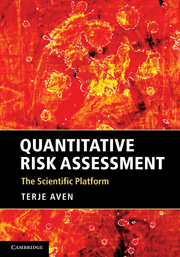Book contents
- Frontmatter
- Contents
- Preface
- Acknowledgments
- 1 Introduction to risk management and risk assessments. Challenges
- 2 Concepts and perspectives on risk
- 3 Science and scientific requirements
- 4 Introduction to case studies
- 5 Risk assessment when the objective is accurate risk estimation
- 6 Risk assessment when the objective is uncertainty descriptions
- 7 Risk management and communication issues
- 8 Towards a holistic scientific approach to risk assessment
- 9 Conclusions
- Appendix A Introduction to probability theory and statistical analysis
- Appendix B Terminology
- References
- Index
5 - Risk assessment when the objective is accurate risk estimation
Published online by Cambridge University Press: 05 June 2012
- Frontmatter
- Contents
- Preface
- Acknowledgments
- 1 Introduction to risk management and risk assessments. Challenges
- 2 Concepts and perspectives on risk
- 3 Science and scientific requirements
- 4 Introduction to case studies
- 5 Risk assessment when the objective is accurate risk estimation
- 6 Risk assessment when the objective is uncertainty descriptions
- 7 Risk management and communication issues
- 8 Towards a holistic scientific approach to risk assessment
- 9 Conclusions
- Appendix A Introduction to probability theory and statistical analysis
- Appendix B Terminology
- References
- Index
Summary
In this chapter we study the scientific platform of risk assessments when the objective of these assessments is accurate risk estimation. We first summarise the key concepts, probability and risk, using the set-up introduced in Chapter 2. We then conduct the assessments for the three cases, and from this basis we study the scientific quality of the risk assessments. Focus is on the scientific requirements of reliability and validity defined in Chapter 3.
The risk assessments presented in Sections 5.2–5.4 are rather comprehensive and detailed, although many simplifications have been made. If the reader is mainly concerned about the discussion of the scientific requirements of reliability and validity, a quick reading of these sections would suffice provided the reader is familiar with the statistical nomenclature and methods used. However, to fully appreciate the discussion in Section 5.5 it is necessary to go into the details of the assessments in Sections 5.2–5.4. For example, we cannot evaluate what the main quantities of interest are in the study or see the importance of key assumptions made in the assessments, without looking into the contexts of the analyses and precisely describing how the analyses are carried out.
- Type
- Chapter
- Information
- Quantitative Risk AssessmentThe Scientific Platform, pp. 51 - 75Publisher: Cambridge University PressPrint publication year: 2011

